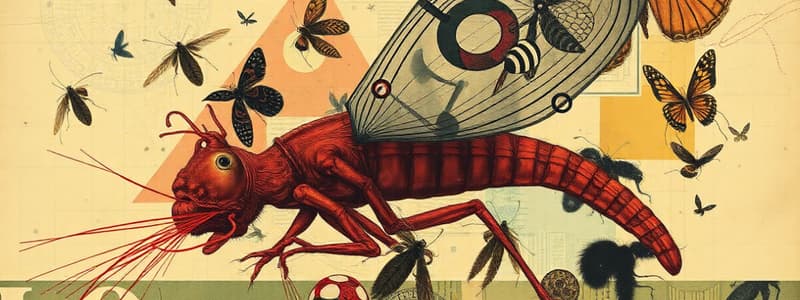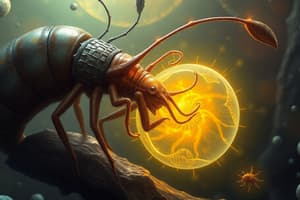Podcast
Questions and Answers
Which mode of transmission involves contaminated food or water?
Which mode of transmission involves contaminated food or water?
- Skin penetration
- Ingestion (correct)
- Direct contact
- Transfusion
Individuals living in close quarters are at lower risk for parasitic infections.
Individuals living in close quarters are at lower risk for parasitic infections.
False (B)
Name one preventive measure for the mode of transmission of parasites.
Name one preventive measure for the mode of transmission of parasites.
Hand hygiene
Parasites can cause __________ effects leading to tissue destruction.
Parasites can cause __________ effects leading to tissue destruction.
Match the following populations at risk with their description:
Match the following populations at risk with their description:
What is the primary focus of parasitology?
What is the primary focus of parasitology?
In mutualism, both organisms benefit from the relationship.
In mutualism, both organisms benefit from the relationship.
What term describes an organism that benefits from another while harming its host?
What term describes an organism that benefits from another while harming its host?
A __________ is an organism that can transmit parasitic infections, often insects.
A __________ is an organism that can transmit parasitic infections, often insects.
Match the types of parasites with their definitions:
Match the types of parasites with their definitions:
Flashcards are hidden until you start studying
Study Notes
What is Parasitology?
- Parasitology is the study of parasites, their hosts, and the relationship between them.
- Parasites are organisms that obtain benefit from another organism (the host).
- Parasitism: One organism benefits while the other is harmed.
- Mutualism: Both organisms benefit.
- Commensalism: One organism benefits while the other is unaffected.
Types of Parasites
- Pathogenic: Causes disease.
- Opportunistic: Only causes disease when the host is weakened.
- Ectoparasite: Lives on the outside of the host (infestation).
- Endoparasite: Lives inside the host (infection).
- Obligate: Must live in a host to survive.
- Facultative: Can live with or without a host.
- Periodic: Temporarily lives in a host.
- Zoonotic: Transmitted from animals to humans.
Types of Hosts
- Definitive Host: Where the parasite reaches sexual maturity.
- Intermediate Host: Where the parasite undergoes larval development.
- Paratenic (Transport) Host: Where the parasite doesn't develop but is transported to a new host.
- Reservoir Host: Harbors the parasite and can infect other hosts.
- Accidental Host: A host that is not normally infected by a parasite.
Vectors
- Biological Vector: Carries the parasite within its body and transmits it to the host.
- Mechanical Vector: Transmits the parasite on its surface.
The Life Cycle of a Parasite
- The sequence of stages needed for a parasite to survive, grow, and reproduce.
- Direct life cycle: No intermediate host is required.
Modes of Transmission
- Ingestion of the parasite: Contaminated food/water, undercooked meat/fish, insect bites, contaminated feces.
- Skin penetration: Contaminated water, soil.
- Oral-fecal route: Feces contaminated with the parasite are ingested.
- Direct contact: Person to person contact.
- Sexual contact: Via the exchange of bodily fluids.
- Blood transfusion: Via contaminated blood.
- Transplacentally: From mother to fetus.
Populations at Risk
- Individuals in underdeveloped areas.
- Refugees, immigrants.
- Travelers.
- Immune-compromised individuals.
- People living in close quarters.
- Children who attend daycare centers.
Prevention and Control
- Breaking the chain of infection:
- Infectious Agent: Diagnosis and treatment, antimicrobial stewardship.
- Reservoir: Cleaning, disinfection, sterilization, pest control.
- Portal of Exit: Hand hygiene, PPE, control of aerosols and splatter, respiratory etiquette, waste disposal.
- Mode of Transmission: Hand hygiene, PPE, food safety cleaning, disinfection, sterilization, isolation.
- Portal of Entry: Hand hygiene, PPE, personal hygiene, first aid.
- Susceptible Host: Immunizations, treatment of underlying conditions, patient education.
Parasite-Host Effects
- Nourishment: Parasite feeds on the host.
- Mechanical Effects: Tissue damage, pressure, obstruction, irritation.
- Toxic Effects: Toxins secreted or waste products excreted by the parasite.
- Secondary Infection: Bacteria can enter the host due to the parasite's presence.
Classification of Parasites
- Protozoology: The study of single-celled organisms.
- Helminthology: The study of worms (multicellular parasites).
- Entomology: The study of insects.
Areas of Study for Each Parasite
- Epidemiology: Distribution, statistics, mortality rates.
- Descriptive Biology: Morphology and structure.
- Ecology and Life Cycle: Infective and diagnostic stages.
- Pathogenesis: Mechanism of disease causation.
- Clinical Features: Signs and symptoms.
- Diagnosis: Methods to identify the parasite.
- Treatment, Prevention and Control: Methods to eliminate the parasite.
Reservoir vs Carrier
- Reservoir: An organism (usually an animal) that harbors a parasite without being affected but serves as a source of infection.
- Carrier: A human that harbors a parasite, shows no symptoms, but can transmit the parasite to others.
Studying That Suits You
Use AI to generate personalized quizzes and flashcards to suit your learning preferences.




